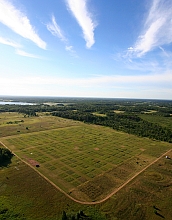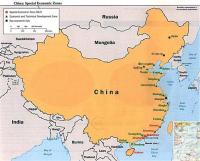 My second attempt at this new renewable energy roundup goodness.
My second attempt at this new renewable energy roundup goodness.
This week we talk about Cape Wind and the its politics, China’s use of renewable energy to help reduce poverty, and using natural prairie grasses as a source of biofuel. All of this and pictures await you after the more. If you have some renewable energy news you think I should know about please don’t be afraid to contact us and let us know.
Lets get started!
Read
Cape Wind’s Prospects Get a Boost
Cape Wind, the proposed wind farm off of Cape Cod (where I spend all my time) got one painfully small step closer to becoming a reality. The Massachusetts supreme court ruled unanimously that the proposed underwater transmission lines that would feed energy from the wind farm to the main land are OK.
Cape Wind President Jim Gordon stated that, “the state’s highest court has now confirmed the validity of the original agency decision, which said emphatically that Cape Wind’s power is needed, that Cape Wind will reduce air pollution and that the project is a needed part of our state’s energy mix.â€
Important findings from the MEFSB Decision approving Cape Wind’s Application May 11, 2005:
- “The record shows that the wind farm will tend to reduce market clearing prices for electricity… The savings…would accrue to electric customers, and are estimated to be $25 million per year for New England customers, including $10 million annually for Massachusetts customers over the first five years of operation.†(p.162)
- “The record clearly documents significant and lasting air quality benefits resulting from the wind farm’s displacement of other, primarily fossil-fueled, generators.†(p.188)
- “Overall, the Siting Board concludes that the air quality benefits of the wind farm are significant, and important for Massachusetts and New England.†(p. 189)
- “The Siting Board therefore finds that there is a need for the capacity provided by the wind farm beginning in 2007 for reliability purposes.†(p.147)
- “The record shows that the wind farm would act as a hedge against risks associated with the availability of natural gas and other fossil fuels.†(p.150)
- “Consequently the Siting Board finds that there will be a need for the renewable resources provided by the wind farm to meet regional RPS [Renewable Portfolio Standards] requirements beginning in 2006.†(p.155-156)
This proposed wind farm has seen more than its fair share of political back room dealings in the past years. It is then also an interesting turn of events that a strong political opponent to the project, Mitt Romney, will soon be leaving. Democrat Deval Patrick was easily elected governor, his early and strong support of the proposed wind farm helped him to that victory.
China to Reduce Poverty by Supporting Renewable Energy
China is taking the first tentative steps towards spreading the renewable energy economy to its people.
From here
The project includes three distinct initiatives and gives priority to ethnic minority communities living in mountainous and remote areas of Guizhou, Sichuan, Xinjiang, and Yunnan provinces and Inner Mongolia. Farmers living along the high-altitude border of Guizhou, Sichuan, and Yunnan provinces, for example, will learn how to cultivate the oil-rich seeds of Jatropha curcas, a wild tree commonly used as a hedge, to produce biodiesel and create a new energy market. After the oil is extracted, the jatropha seed cake is also rich in nutrients that are essential to the fertility of the soil; therefore, large-scale cultivation of the tree can both provide a sustainable energy source and prevent soil erosion and desertification of local farmland.
According to project coordinator Yunsong Xu, the goal is to expand the current area of nearly 27,000 hectares of jatropha trees to more than 270,000 hectares by 2012, boosting local household incomes by an estimated 500-700 yuan (US$64-89) annually. The project will also set up associations to coordinate local farmers and create new enterprises to explore the market potential for renewable energy, Xinhua News reported.
A second initiative of the Green Poverty Reduction Project will be expanding the cultivation of Jarrah Dayun, a raw material for traditional medicine, in northwest Xinjiang Uygur Autonomous Region, to an area of 600 hectares and covering 1,000 households. The third main project activity will be providing small-scale wind turbines to herdsmen in the Inner Mongolia area.
America can ill afford to allow the rest of the world to switch over to a renewable economy and still be stuck in the antiquated days of fossil fuels. We could be providing thousands of high paying high tech jobs to Americans if we supported similar projects here at home.
Mixed Prairie Grasses Better Source of Biofuel Than Corn Ethanol and Soybean Biodiesel

Diverse mixtures of native prairie plant species have emerged as a leader in the quest to identify the best source of biomass for producing sustainable, bio-based fuel to replace petroleum.
A new study led by David Tilman, an ecologist at the University of Minnesota, shows that mixtures of native perennial grasses and other flowering plants provide more usable energy per acre than corn grain ethanol or soybean biodiesel and are far better for the environment. The research was supported by the National Science Foundation (NSF) and the University of Minnesota Initiative for Renewable Energy and the Environment.
“Biofuels made from high-diversity mixtures of prairie plants can reduce global warming by removing carbon dioxide from the atmosphere. Even when grown on infertile soils, they can provide a substantial portion of global energy needs, and leave fertile land for food production,” Tilman said.
The findings are published in the Dec. 8, 2006, issue of the journal Science.
The is study based on 10 years of research at Minnesota’s Cedar Creek Natural History Area, one of 26 NSF long-term ecological research (LTER) sites. It shows that degraded agricultural land planted with diverse mixtures of prairie grasses and other flowering plants produces 238 percent more bioenergy on average than the same land planted with various single prairie plant species, including switchgrass.
“This study highlights very clearly the additional benefits of taking a less-intensive management approach and maintaining higher biodiversity in the process,” said Henry Gholz, NSF LTER program director. “It establishes a new baseline for evaluating the use of land for biofuel production.”
Tilman and his colleagues estimate that fuel made from this prairie biomass would yield 51 percent more energy per acre than ethanol from corn grown on fertile land. Prairie plants require little energy to grow and all parts of the plant above ground are usable.
Fuels made from prairie biomass are “carbon negative,” which means that producing and using them actually reduces the amount of carbon dioxide in the atmosphere. Prairie plants store more carbon in their roots and soil than is released by the fossil fuels needed to grow and convert them into biofuels. Using prairie biomass to make fuel would lead to the long-term removal and storage of from 1.2 to 1.8 U.S. tons of carbon dioxide per acre per year. This net removal of atmospheric carbon dioxide could continue for about 100 years, the researchers estimate.

One thought on “Renewable Energy Roundup”
Comments are closed.